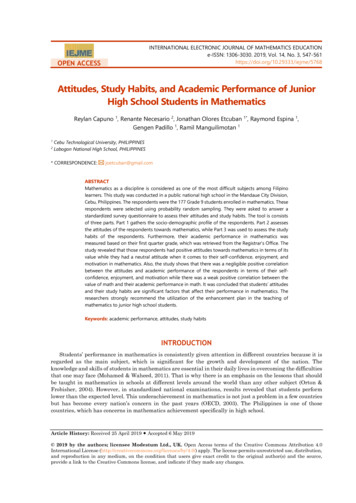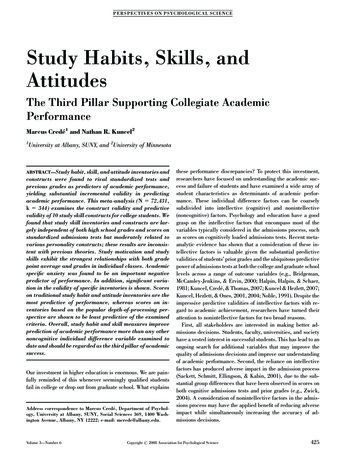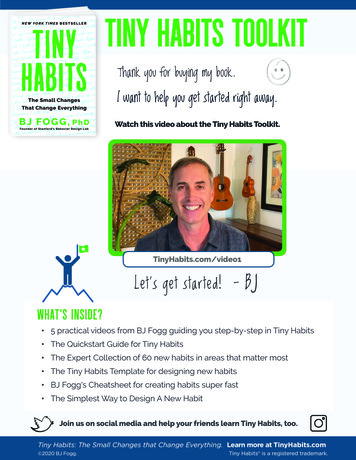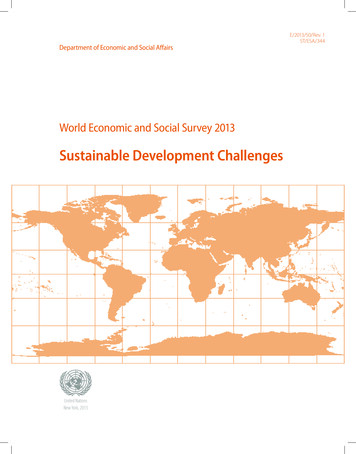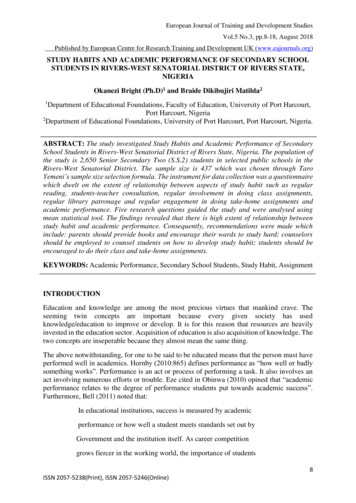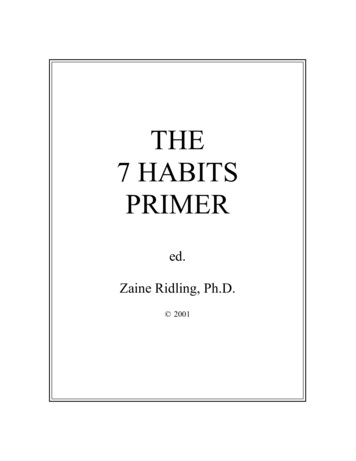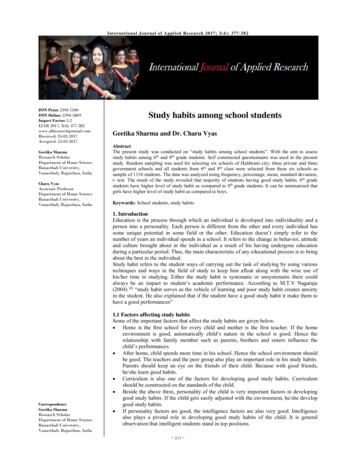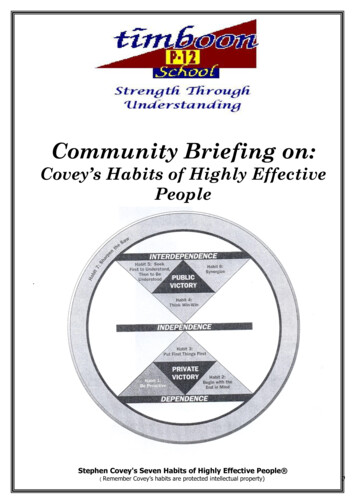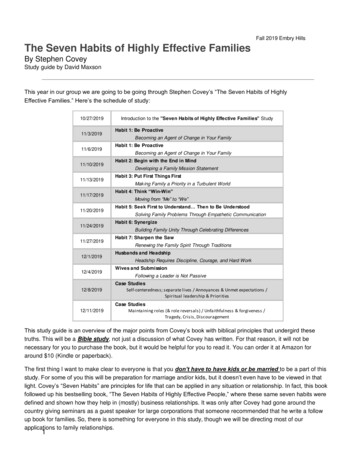
Transcription
UPPSATSER:Kulturgeografiska institutionenAttitudes towards sustainable development:Habits, choices and awarenessA field study of Cuban university students’ andprofessors’ everyday life concerning sustainabledevelopmentAgnes Kristoffersson and Cornelia Wallander
ABSTRACTKristoffersson, A. and Wallander, C. 2017. Attitudes towards sustainable development: Habits, choices andawareness. Arbetsrapportserie. Uppsala universitet.In 2006, Cuba was the only country in the world that met the criteria for sustainable development as defined byWorld Wildlife Fund. To solve some environmental issues, it is necessary to investigate environmental behaviourand attitudes among the Cuban population. The aim of this thesis was to examine the attitudes towards sustainabledevelopment among a selected group in the Cuban society and what individual factors that may have contributed.The selected group that was investigated contained students and professors from the University of Cienfuegos.The study was performed as a fieldwork in Cienfuegos and the collected data was received through aquestionnaire and interviews at the University of Cienfuegos. The questionnaire was distributed to students andprofessors at the university and six individual interviews were held with different professors to get a deeper insighton the subject. The collected data was analysed through a theoretical framework based on factors that influence anindividual’s environmental behaviour. There are many external factors that contribute to the sustainabledevelopment in Cuba. The investigated group does not make many conscious choices in their everyday life to livesustainably and the extent of conscious choices are low. Economic restrictions are a central factor for both lowconsumption and small emissions from transportation. The US embargo has had a great influence on the currentsituation as well.Keywords: Sustainable development, Ecological Footprint, environmental behaviour, conscious choices, Cuba,University of CienfuegosSupervisor: Marat Murzabekov
TABLE OF CONTENTS1. INTRODUCTION . 41.1 Problem formulation and questions . 51.2 Disposition . 52. BACKGROUND. 62.1 Concepts . 62.2 Cuba and the city of Cienfuegos. 73. THEORY AND PREVIOUS RESEARCH . 93.1 Framework . 94. METHODOLOGY . 134.1 Fieldwork and ethical concerns . 134.2 Observation . 144.3 Questionnaire . 144.4 Qualitative interviews . 154.5 Triangulation . 164.6 Usage of interpreter . 174.7 Sources of error . 175. ENVIRONMENTAL BEHAVIOUR AND ATTITUDES . 195.1 Environmental values . 195.2 Situational variables . 205.3 Psychological factors . 256. DISCUSSION . 277. CONCLUSION . 31REFERENCES . 32APPENDIX 1 . 35APPENDIX 2 . 38APPENDIX 3 . 39APPENDIX 3 . 40APPENDIX 4 . 41
1. INTRODUCTIONThe global climate and the alarming consequences that human activities may lead to is aproblematic issue that the public faces daily. Although the climate is a well discussed issue andthere are many regulations and commitments, the environment is under threat (Department ofEconomic and Social Affairs, 2013, p. iii). There are a lot of unsustainable production andconsumption patterns that must change and the developed countries are the ones that must leadthe way (United Nations, 2015, p. 8). However, measurements from the beginning of 20thcentury clearly indicate that we are using the natural resources on Earth in a higher rate thanthey are renewed (WWF, 2006).To get a better overview of the situation on the planet, the World Wildlife Found, WWF,investigates the level of sustainable development that each country attains. Since 1998, theorganisation has published a Living Planet Report, LPR, every two years which containsinformation about the global impact on the planet as well as the natural state of the world. TheEcological Footprint in high and middle income countries increased significantly between1961-1970. Simultaneously, many people in the developing countries still suffer from poorliving standards with poverty, absence of education and low life expectancy. There are twomeasures that a country must fulfil for meeting the criteria for sustainable development: anacceptable Ecological Footprint below the value 1.8 gha and a high Human Development Index,HDI, over 0.8. In WWF’s LPR from 2006, they declared that only one country in the worldobtained a sustainable development with both criteria approved and that was Cuba (WWF,2006).1This can be seen as a remarkable accomplishment, given the challenges Cuba has facedduring the 20th century. Revolutions that resulted in a communist one-party rule and a lack ofliberty of speech, in combination with the long-lasting embargo from the United States, haveresulted in extended economic problems for Cubans. According to estimations from the Cubangovernment, the country has lost nearly 753.7 billion USD due to the American embargo (Cubavs Bloqueo, 2016, p. 2). So, despite of the sustainable society with low Ecological Footprintand a high HDI-value, many challenges has resulted in Cuba still being ranked as one of manydeveloping countries in the world (International Union of Geodesy and Geophysics, 2015).Cuba is a counter-example to an assumption that countries with high incomes should alsohave best conditions to be sustainable. Citizens in these countries can do conscious choices,such as buying ecological products, eating less meat and buying vehicles which run onrenewable energy. Technological development combined with a lifestyle which has room forchanges gives opportunities to change habits. However, people in developed countries areunwilling to do so. A report from the Swedish Environmental Protection Agency indicated thatmany people do not want to have a sustainable lifestyle since they are unwilling to accept amaterial loss. People assume that the problems always can be solved by technical solutionsinstead (Sanne 2012, p. 126). The persisting question is what kind of attitudes that are reflectedin the Cuban society and if they have a greater willingness to live sustainable compared to thedeveloped countries.1For more detailed information regarding the concepts HDI and Ecological Footprint, see chapter 2.1.4
1.1 Problem formulation and questionsTo strive for, and eventually succeed with, the vision of a global sustainability and solvedenvironmental issues, the first essential thing is to investigate the current living habits and whypeople behave the way they do. Also, the analyses regarding attitudes and awareness arenecessary as well to obtain an estimation of what possible changes and sacrifices in the everydaylife that people are prepared to make. Therefore, the aim with this study is to examine theattitudes towards sustainable development among a selected group of the Cuban population.The fieldwork was performed as an 8-week long fieldwork in the Cuban city of Cienfuegos andtherefore the study investigated only the population in this city. We have been informed that itis obligatory for the government to give permission in cases where people outside of theuniversity are interviewed or recruited as research participants. This required permission couldtake many weeks to receive. Therefore, the study only included respondents such as studentsand professors from the university since they clearly are a group that are easily accessible forforeign researchers. This group was also suitable for this study since they are the most likelygroup to possess information regarding sustainable development and the environmentalawareness in a developing country. In order to determine their attitudes, the purpose of thisstudy is also to investigate their standard of living and habits concerning an environmental andsustainable aspect. This study solely focused on the Ecological Footprint and factors that affectit.This leads to the following principal questions of the study: Which factors, at an individual level, among the selected students and professors mayhave contributed to a good sustainable development? To what extent do Cuban university students and professors make conscious choices inthe daily life to maintain the sustainable development?1.2 DispositionThe report is divided into seven chapters, where chapter 2 present a short background withclarifying of different concepts and information about Cuba and Cienfuegos. Chapter 3represent the theoretical framework of this study as well as previous research, where the theoryimplemented on the study is explained and it is followed by the used methodologies, chapter 4.The fourth chapter partly contains information regarding how a fieldwork is performed, as wellas the quantitative and qualitative methodologies that were used. Chapter 5 contains the resultsof the study, which are followed by the discussion in chapter 6 and lastly conclusions in chapter7.5
2. BACKGROUND2.1 ConceptsSustainable development is a concept with several diverse definitions and in this study, the onefrom WWF is used. In the Living Planet Report from 2006, the organisation formulated thefollowing definition (WWF, 2006):Sustainable development is a commitment to improving the quality of human life while living within thecarrying capacity of supporting ecosystems.By combining the Human Development Index (HDI) and the Ecological Footprint, the criteriafor sustainable development can be fulfilled for a certain country (WWF, 2006).HDI was created by the UN agency United Nations Development Programme, UNDP. Theintent was to reflect the fact that people and their abilities should be the central factor forevaluating a country’s possibilities for human development. It contains three parts; expectedlength of life, education and decent standard of living, which together adapts an average resultthat is the HDI. Although the HDI reflects some parts of human development, it does not giveany indications of inequalities, poverty or security for the population in the country (UNDP).The index represents a value between 0-1 and according to UNDP, a “high humandevelopment” is obtained at a value of at least 0.8 (WWF, 2006).WWF studies the state of global biodiversity combined with human use of natural resourcesof the world. These two parts are evaluated through Living Planet Index and EcologicalFootprint. The Living Planet Index indicates the well-being of different ecosystems on theplanet and their biological diversity, while Ecological Footprint indicates the biologicallyproductive area humans require to cover their demand and to absorb the emissions of carbondioxide (WWF, 2006). The footprint of a country can be measured in amount of global hectares,gha, which is a value indicating how many hectares each person on earth can dispose. Whendividing the earths total bio productive area with the amount of population, each person hastotally 1.8 gha at his disposal (WWF, 2010). Since the 1980’s, humans are using the naturalresources in a higher speed than they are produced and the United Nations is concerned that thehuman demand will be twice as big as the planets productive capacity around year 2050 (LPR,2006). In 2007, a general person required 2.7 gha in biocapacity2 (WWF, 2010).When WWF investigates an individual’s Ecological Footprint they focus on four areas:food, travel, home and stuff. The food area contains questions regarding the amount of meat aperson eats, how often they eat at restaurants, how much food that turns into waste and theamount of locally produced food that is bought. According to WWF, the meat production has agreat influence on the environment and in this study all sort of meat, for example chicken, beefand pork meat, is referred to as “meat” (WWF, 2017). The travel area focuses on the most usedtransportation vehicles, the use of train and bus and number of non-business return flights thatare made. In the home area, things like amount of rooms in the house, number of people livingthere, way of heating the house, usage of renewable electricity, turning of lamps and installed2WWF uses the concept biocapacity when talking about how much productive area an individual can dispose.6
efficiency improvements are investigated. The stuff area covers the individual’s consumptionhabits regarding household items, clothes, pets, health products, phone subscription andinternet, as well as which waste that are recycled (WWF, n.d.).2.2 Cuba and the city of CienfuegosCuba is an island situated between US, Bahamas, Jamaica, Haiti and Mexico and in 2014 thetotal Cuban population were about 11.2 million people (Oficina Nacional de Estadística eInformación, Territorio, p. 4 and p. 7-8). The country was a Spanish colony until the end of the19th century. US invaded Cuba in 1898 and owned the main part of the Cuban territory,electricity-, telephone- and oil companies, banks and industries until the 1950’s. This changedafter the revolution and victory of Fidel Castro in 1959 and the US simultaneously ended theexport of oil and sugar to Cuba (Strömdahl, 2015). US tried to invade Cuba and retake thepower in 1961, but they lost the battle in the Bay of Pigs. Thereafter, the US embargo increasedwhich resulted in a Cuban dependency of the Soviet Union and Eastern Europe. Therefore, thedissolution of the Soviet Union in the beginning of 1990’s lead to difficult economicconsequences for Cuba. The US embargo has resulted in the situation, where no Americancompanies have been able to trade with Cuba, which had a deep impact on the Cuban economy(Horvatovic, 2014). During his time as US president, Barack Obama worked hard to reduce theextent of the embargo and he was the first president of the United States that visited Cuba since1928 (Roth, 2016).As mentioned before, Cuba was the only country that fulfilled both HDI and EcologicalFootprint in the LPR from 2006 (WWF, 2006). The HDI value for Cuba has increased duringthe last years which mostly depends on great investments in both education and health care. In2014, the Cuban HDI had increased to 0.815 which gave them the global ranking of 44(Strömdahl, 2015). The value of the Cuban Ecological Footprint was 1.5 gha in 2006 (WWF,2006). It has changed during the latest years and in the LPR from 2012 their EcologicalFootprint had increased to slightly above the approved value. This could probably be explainedby an increased footprint from cropland (Strömdahl, 2015).Cienfuegos is the name of a province and city in the southern-central part of Cuba, see themap in Figure 1. The city is situated around a natural bay and was founded in 1819 byimmigrants from France (Lonely Planet, n.d.). In 2014, the city had a population of about 175000 inhabitants (Oficina Nacional de Estadística e Información, Territorio, p. 10). Cienfuegoshas been the trading place and center for production of tobacco, sugar canes and coffee and in1860’s Cienfuegos was seen as the third most important city in Cuba regarding the economicalwealth (Unesco, n.d.). The average monthly salary in the province of Cienfuegos, in stateowned and mixed entities, was about 609 Cuban Pesos in 2014, which corresponds to about 25CUC and 250 SEK (Oficina Nacional de Estadística e Información, Empleo y Salarios, p. 13).Cienfuegos has a university, Universidad de Cienfuegos, and it consists of two differentcampuses with a total amount of 10 000 students (Interview 1). The university was founded in1979 and has five different faculties: Mechanic, Computer Science, Science in Economics andBusiness, Social Science and Humanities and Agricultural Science (Universidad de Cienfuegos,n.d.).7
Figure 1. A map over Cuba, received from Zenarasailing.8
3. THEORY AND PREVIOUS RESEARCH3.1 FrameworkMany political leaders want to assume that environmental behaviour depends on individualchoices and that bad environmental habits can be changed through a linear model (Barr andGilg, 2007). As Barr and Gilg (2007) mentions, there is a high expectation among politiciansat national level that knowledge spread to the public is enough for solving the environmentalproblems and that changes in people’s way of acting is the main solution. This kind of linearmodel is too simple and according to Stewart Barr et. al (2001) the subject is more complicatedthan that. Instead, they created a framework with different factors that may influence anindividual’s environmental behaviour. This is a framework that can be applied on various typesof environmental behaviours, for example choice of transport, consumerism, wastemanagement etc., and it can also be slightly modified depending on the field of application. Theadvantage of Barr’s framework is that it investigates the environmental behaviour at a deeperlevel and expands the number of factors that may affect it. There can be a presumed connectionbetween a person’s values and behaviours, which is the central element of the framework.Although, this cannot be seen from one perspective since many other factors interact as well.Therefore, it is also a need of applying a social-psychological perspective when investigatingthis subject as it involves a greater depth than just knowledge (Barr and Gilg, 2007).An illustration of the framework can be seen in Figure 2 at page 12. The framework isbased on three different groups of predictors: environmental values, situational variables andpsychological factors (Barr, Gilg and Ford 2001). It can also interact with other factors that,according to us, may have an influence on environmental behaviour as well. Therefore, someparts have been added to Barr’s framework.3.1.1 Environmental valuesThe environmental values are variables that may have an apparent effect on the actual individualactions (Barr, Gilg and Ford, 2001). Since the middle of the 1990’s, researchers like Stern et.al (1995) and Cameron et. al (1998) have indicated that individual’s estimations and socialvalues interact with their environmental actions. For example, Barr (2004) argued that personalattitudes towards the environment affect the individual’s environmental behaviour regardingwaste management. He pointed out that people that are, so called, ecocentric are more likely tocontinuously act environmentally friendly since they believe that nature has an essential value.On the other hand, people thinking that humans are the most fundamental part of the world areconsidered anthropocentric and they often assume that the environmental problems can be fixedby technological solutions. This group has shown to be less willing to recycle and actenvironmentally friendly than the ecocentrics (Barr, 2004).Nevertheless, the correlation between attitudes and environmental behaviour is not strongand some studies have not been able to discover correlation at all. For example, Oskamp et.al.’s (1991) study regarding kerbside recycling in Canada did not find any correlation betweenattitudes and behaviour among the respondents. Scott and Willits (1994, p. 255) mention thatthe observable correlation may even be a result of people learning the importance of sympathyfor the environmental problems. So, when answering the questions about their behaviour,9
people are aware of the morally correct answer whereas their real environmental behaviour isnot changed at all (Scott and Willits 1994, p. 255). But even if there is a weak correlation, theenvironmental values are important factors that represent individual’s essential attitudesregarding the environment (Barr, Gilg and Ford 2001).3.1.2 Situational variablesThe situational variables are factors that reflect individual’s personal circumstances at a chosentime, which can be physical features, geographical location, economical assets and knowledge(Barr and Gilg, 2007). It is a variable that can vary and change depending on differentconditions in a persons’ life. The intention is to both reflect individual’s availability to wastemanagement and other environmental actions, as well as how great their knowledge is regardingthese actions. For example, constant availability of kerbside recycling bins makes it easier forpeople to take care of the garbage instead of throwing it on the street (Barr, Gilg and Ford,2001). This part also includes the amount of sacrifices that a person is willing to provide foracting more environmental friendly. Today, there are a lot of substantial changes that can bemade in a house that results in great differences, like installing water saving devices in the toiletand use LED-lamps for example (Barr and Gilg, 2007).As mentioned, knowledge regarding environmental actions is important and it is a variablethat may affect the environmental behaviour. According to Oskamp et. al (1991), well-informedpeople regarding the environmental situation also possess behaviours that reflect thisknowledge. Schahn and Holzer (1990) discovered that concrete knowledge, i.e. knowledgeapplicable to environmental protection, should be seen as an important and necessaryqualification if people should act in an environmentally friendly way. For example, it is easierto recycle if one has recycled before or if one has the knowledge of what to recycle and were.(Barr, Gilg and Ford 2001). So, experience is an important factor and it may influence otherforms of environmental behaviour as well (Barr and Gilg, 2007). Daneshvary et. al.’s (1998)study, that is mentioned in Barr (2004), indicated that those people that had implemented paperrecycling in their homes, were also more likely to recycle their clothes.Another situational variable is related to incomes, since inequalities in income also mayinfluence behaviour. For example, the ones having a good financial income can manage toconsume goods and services which leads to harmful environmental outcomes. This is notpossible in the same extent for the ones having a lower income (Sanne, 2012, p. 131).3.1.3. Psychological factorsThe third part of the framework is psychological factors that reflect a person’s individual traitsand characteristics. It is apparent that it is easier for people with morality and intrinsic motivesto do environmental actions, which they consider as contributing to positive consequences. Byfeeling some sort of satisfaction and pleasure, when for example recycling, it is easier tomaintain this behaviour in the future and probably easier to initiate further environmentalactions as well. When considering the act having a positive importance for the problem and thatit is making a great difference for the environment on a local or global level, it is presumed toenhance the environmental behaviour as well (Barr and Gilg, 2007). For example, manyenvironmental-aware people chose to take bus or bike instead of car since they know it results10
in less emissions effecting both the local air and global atmosphere. Some people experiencehigher motivation when doing things effecting on a local level, like recycling at home, since itresults in positive consequences for the own society and welfare (Barr, Gilg and Ford 2001).It is also possible that the behaviour is influenced by an experienced threat regardingclimate problems and that a person is considered having a responsibility for addressing theseproblems (Barr and Gilg, 2007). Social pressure and normative efforts from people livingnearby is also a reason for individuals to start acting environmentally friendly (Barr, Gilg andFord, 2001). Friends, family and other persons around you may also have a central role in theway you behave environmentally, where for example consumption is something that easily getsencourage by people in the social society (Barr and Gilg, 2007).In many situations, consumerism is not only considered as something useful and necessarybut rather an act that results in great pleasure and enjoyment. The concept romantic ethics ofconsumerism refer to human desire and expectations that many people experience beforeconsuming products, which often is more enjoyable than the actual usage. This results in aconstant feeling of being unsatisfied, which increases the individual consumerism and thereforeleads to a higher production of different products (Giddens and Sutton 2015, p. 130-132).Consumerism is also based on the constant pursuit for social status and by buying trendy anddetailed products it is possible to identify your stylish personality and express a higher character(Giddens and Sutton 2015, p. 130-132). Sanne (2012) claims that people are unwilling tosupport the idea of having a sustainable lifestyle if it imposes a loss in material standard. Onemain answer to people’s unwillingness to accept losses, also called the loss aversion, is theexpectation of improvements which means that even a deceleration of the growth would be afailure (Sanne 2012, p. 126-127).Consumer products have also a tendency in becoming necessary and required in theeveryday life. Giddens and Sutton (2015) refer to the example with private vehicles and the factthat many household possesses at least one or two cars. These cars are not solely used for longertrips but rather for shorter distances when walking or biking would have been an equallyapplicable alternative. Besides being the most common transport vehicle, the car may be asymbol of freedom and independence for both young and older people. An investigation madein north western England demonstrated that it is possible to divide car drivers in six differentgroups of consumers depending on their values and opinions. The investigation resulted in thatthe most important groups, seen from an environmental perspective, were the two smallest ones:Car-free environmentalists and Unwilling passengers. Car-free environmentalists were totallyavoiding car driving because of environmental reasons and used the public transport instead.Unwilling passengers included people that by some reason, medical or economic for example,did not own a car and used the public transport or were transferred by others (Giddens andSutton 2015, p. 130-132).Acting environmentally friendly requires time and a positive approach that the activitiescan be implemented in the everyday life even though it sacrifices the convenience (Barr andGilg, 2007). For example, an environmentally friendly person choses to take bike instead of cara rainy day, even though it takes longer time and results in wet clothes. This factor is interfacedwith some parts of the situational variables since it concerns things like how much space aperson can spare for environmental acting in their homes. (Barr, Gilg and Ford, 2001).11
3.1.4 The modelFigure 2. An overview of the environmental behaviour (adapted from Barr, Gilg and Ford, 2001).12
4. METHODOLOGYFirst of all, an improved understanding of the Cuban community, culture, history, its customsand traditions was required before we left for our Minor Field Study. It was also essential to getan improved understanding of the American embargo and its impact on the Cuban developmentand economy. Information regarding this was received through articles, webpages and books.We also participated in a mandatory Minor Field Study course where we learnt about customsand traditions of the Cuban society.4.1 Fie
Kristoffersson, A. and Wallander, C. 2017. Attitudes towards sustainable development: Habits, choices and awareness. Arbetsrapportserie. Uppsala universitet. In 2006, Cuba was the only country in the world that met the criteria

